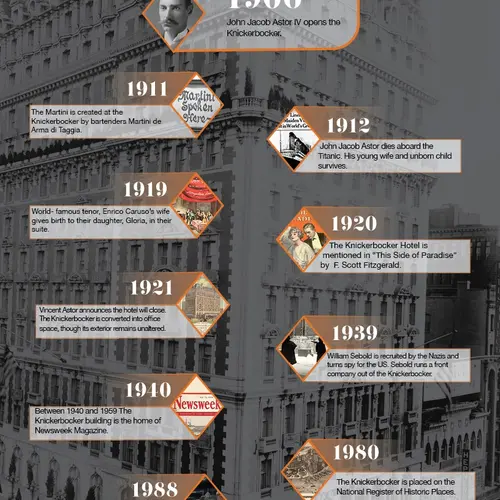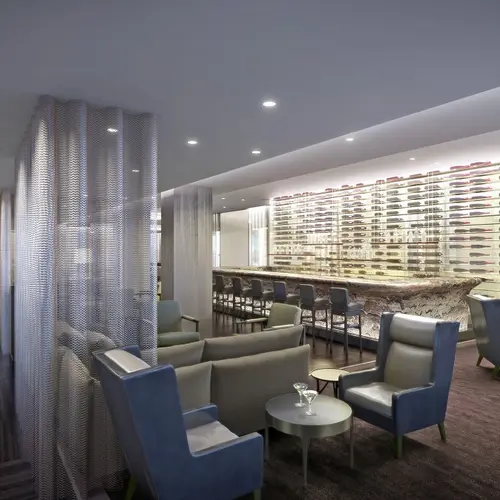The Knickerbocker: Times Square’s First Luxury Hotel Is Reborn as a Modern Landmark
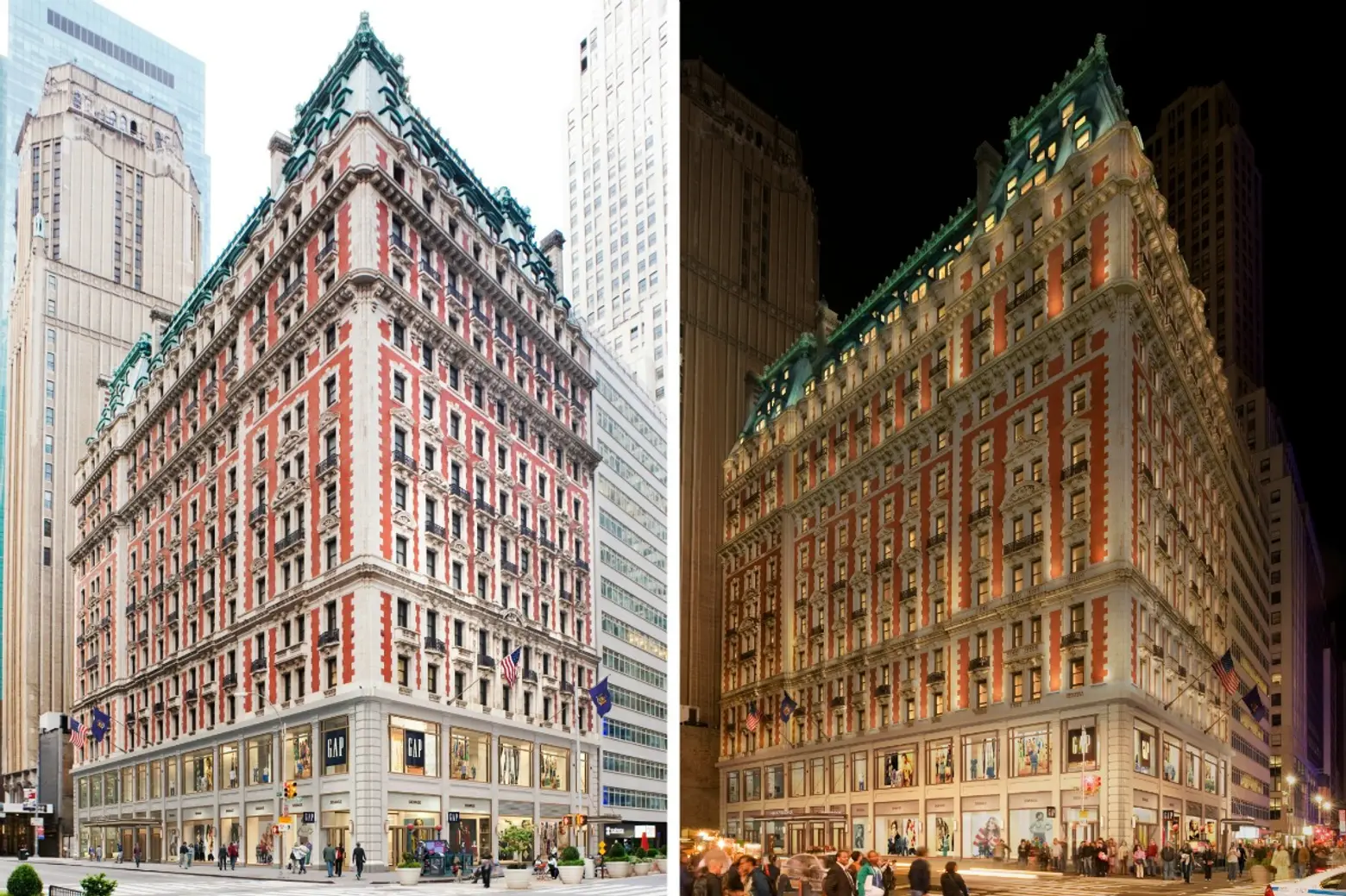
When John Jacob Astor IV built the Knickerbocker Hotel in 1906, he launched a generation of luxury Times Square hotels. The Beaux Arts masterpiece attracted the likes of F. Scott Fitzgerald, John D. Rockefeller, and Italian tenor Enrico Caruso. It was the birthplace of the martini and the site where the sale of Babe Ruth from the Red Sox to the Yankees took place. But after just 15 years, the hotel’s success declined just as fast as it emerged and it was repurposed as an office space, later becoming the Newsweek Building.
Today, though, the landmark is reclaiming its title of ultimate luxury hotel under its original moniker. After a two-year, $240 million modern renovation, the Knickerbocker offers 330 guest rooms, a rooftop bar and lounge with the ultimate view of the Times Square ball drop, and a foodie destination restaurant from chef Charlie Palmer.
TIMES SQUARE’S FIRST LUXURY HOTEL
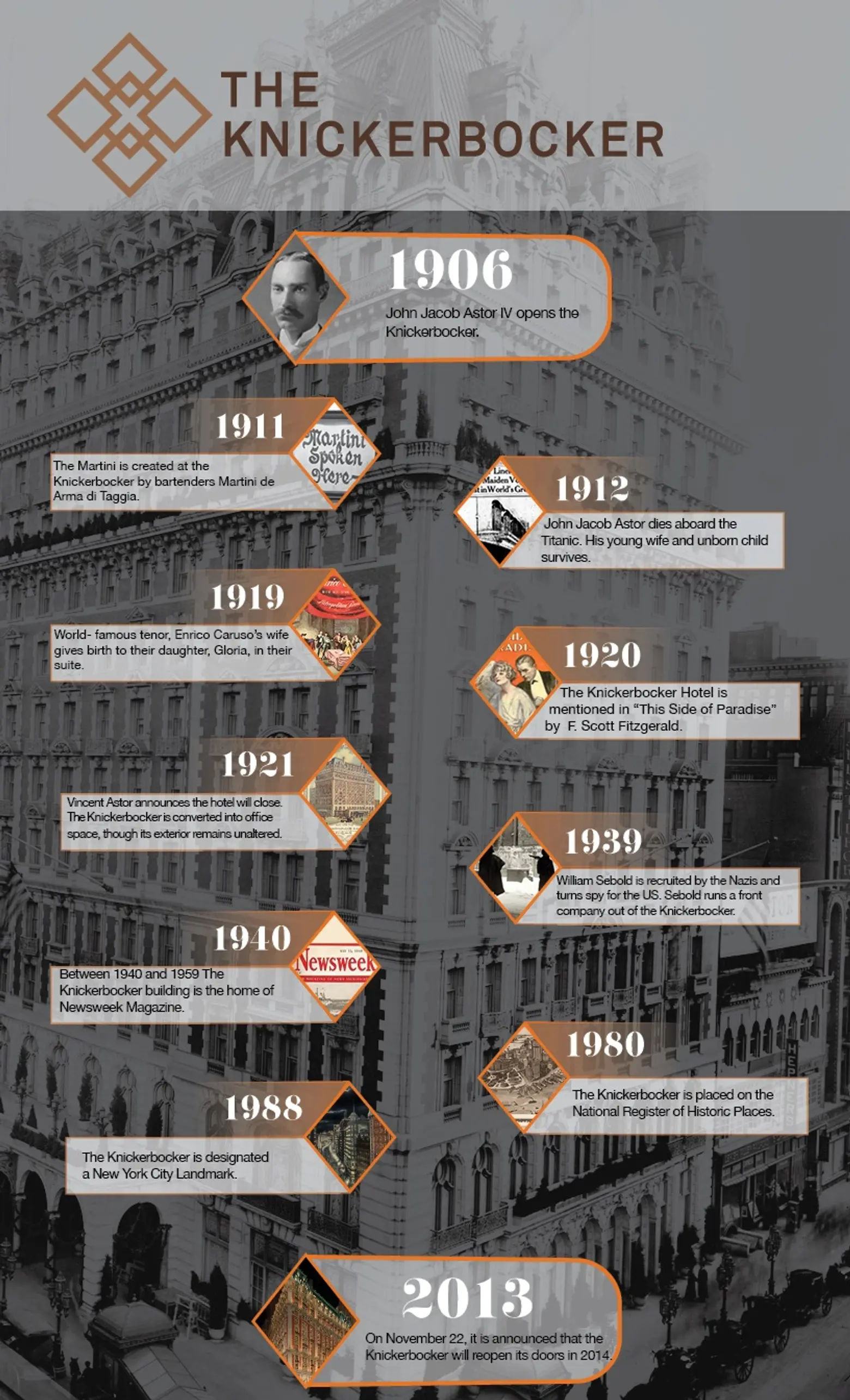
courtesy of the Knickerbocker Hotel
At an 1845 estate auction, John Jacob Astor IV bought ten Times Square plots that later combined to form the property where the Knickerbocker stands. He paid $23,080 for the land, and in 1903, a Philadelphia development company headed by J.E. and A.L. Pennock financed the construction of the hotel. They hired architects Bruce Price and Marvin & Davis to design the building in a French Renaissance style, but one year later the Pennock’s company collapsed and the building was left as an incomplete shell. In May 1905, Astor took control of the project and hired architects Trowbridge & Livingston to complete the interiors. The firm had just worked on his St. Regis Hotel.
The $3.3 million Knickerbocker Hotel opened on October 23, 1906 with 556 rooms, fancy bars and restaurants on the first three floors (to accommodate 2,000 after-theater diners), and a 30-foot-long mural of Old King Cole by Maxfield Parrish adorning the bar. This bar became so popular, in fact, that it was nicknamed “The 42nd Street Country Club.” The hotel even had its own subway passageway at the east end of the platform for the 42nd Street shuttle (the “Knickerbocker” sign can still be seen over the doorway there today).
FAMOUS FIGURES

The hotel’s original martini cart © Yuka Yoneda of Inhabitat NYC (L) and the drink recipe via Knickerbocker Hotel (R)
Perhaps what makes the Knickerbocker so well known and iconic is the slew of famous figures who passed through its doors. In 1912, the house bartender, Martini di Arma di Taggia, is said to have invented the aptly named martini. He mixed dry vermouth and gin, getting the attention of John D. Rockefeller.
Other famous residents of the hotel include world-famous opera singer Enrico Caruso, who lived in the hotel from 1909 until his death in 1921, taking all his meals in the hotel restaurant and always using the same set of cutlery. He was by far the hotel’s most famous resident, partaking in quirky shows like leading a crowd on the street in a rendition of “The Star-Spangled Banner” on Armistice Day. George M. Cohan, the father of American musical comedy, on whom “Yankee Doodle Dandy” is based, was another long-time resident.
In 1908, the National Democratic Club invited Dr. Woodrow Wilson, then president of Princeton University, to address its annual meeting. Five years later he was elected the 28th President of the United States. In 1910, the world’s most famous ballet dancer, Anna Pavlova, the prima ballerina of the Imperial Russian Ballet, stayed at the Knickerbocker while performing at the Metropolitan Opera House. And in 1911, after Harry Atwood completed what was then the longest flight ever recorded–from St. Louis to New York–he made his way to the Knickerbocker after landing at Governors Island. The hotel then offered a $1,000 “Knickerbocker Prize” to any pilot who could break the record for the longest flight with a passenger (1 hour, 54 minutes, and 42 seconds), which was won almost immediately by a pilot named T. De Witt Milling.
THE END OF AN ERA
After John Jacob Astor IV died on the Titanic in 1912, his son Vincent Astor inherited the hotel. Things ran smoothly at first, but when prohibition was enacted in 1919, business at the hotel’s restaurants and bars declined, and in 1921 Astor decided to convert the building into offices. Though the building wouldn’t be landmarked until 1980, Astor decided to keep the façade unchanged. But he hired architect Charles A. Platt to convert the ground levels to retail space and the remaining floors as office suites. From 1940 to 1959 Newsweek magazine operated out of the building, giving it the moniker The Newsweek Building.
When the commercial market hit a slump in 1980, investors Harry Helmsley and David Baldwin converted the Knickerbocker into residential lofts known as 1466 Broadway. This lasted only a short time, and when the market recovered the units were rented as showrooms and studios for companies in the Garment District.
In 2004, developer SL Green sold the building, then known as 6 Times Square, to Sitt Asset Management, who in turn sold it in 2006 to Istithmar Hotels, a Dubai-based investment group. Istithmar planned to convert the building back to a luxury hotel, but couldn’t pay their debt and surrendered the property to their lender in 2010.
THE KNICKERBOCKER REBORN

Present-day renderings of the Knickerbocker Hotel © NeoScape
In 2012, real estate investment trust FelCor Lodging Trust bought the Knickerbocker for $115 million, then spent an additional $240 million on a gut renovation that returned the building to a hotel. The new sleek, contemporary interior was designed by Gabellini Sheppard (who also recently restored the iconic Rainbow Room) and features a wealth of opulent Carrara marble and gold leaf. The ground floor remains as retail space.


Guest rooms © Rick Lew
The rooms average 430 square feet apiece and start at around $500-$700 per night. Their walls are intentionally bare, meant to evoke the feeling of serenity, which is also achieved by the soundproof walls (this is Times Square after all).

Jake’s at the Knick © Rick Lew
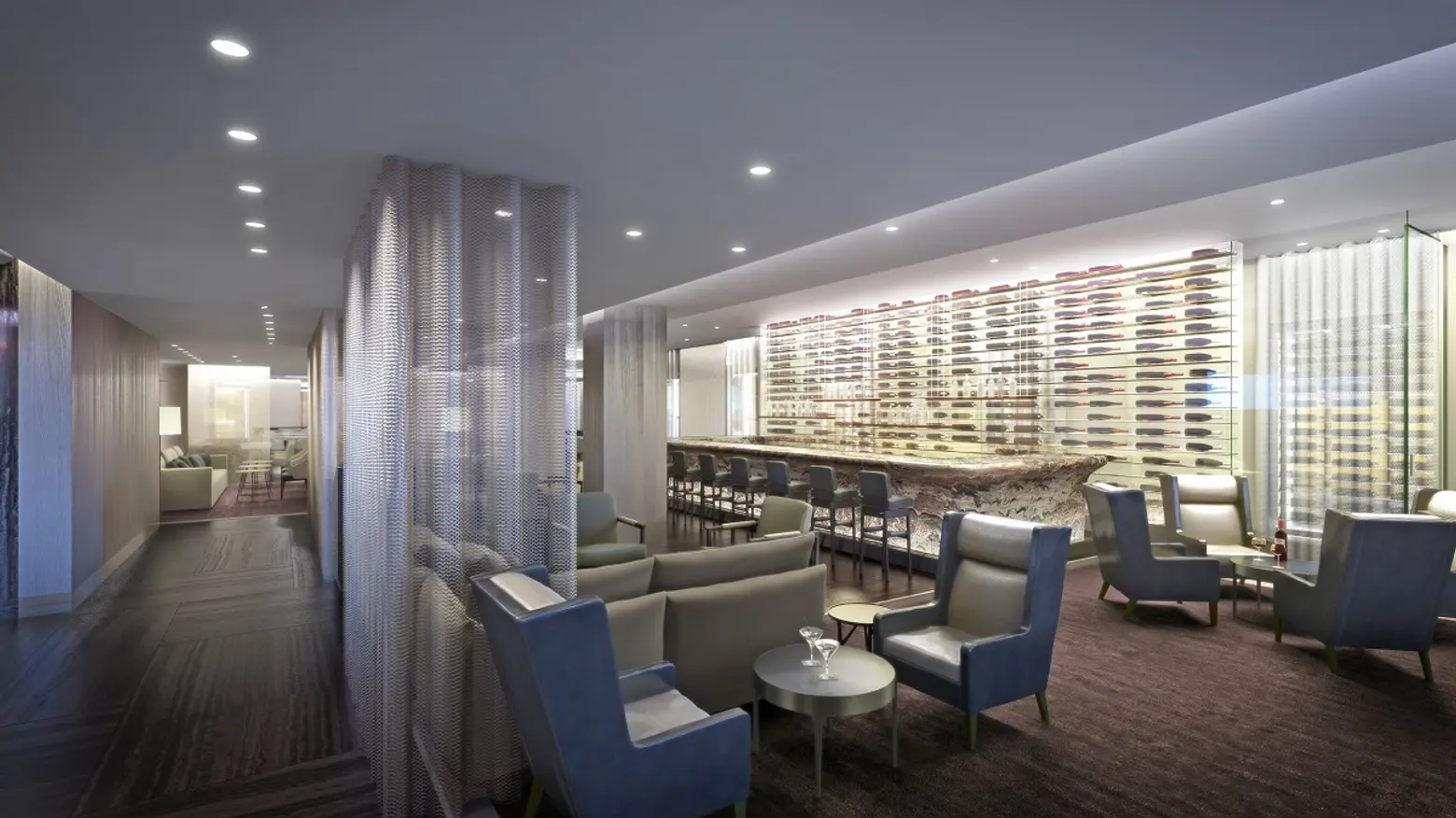
Charlie Palmer at the Knick © Rick Lew
The ground-floor café, Jake’s at the Knick, resembles a subway tunnel, a clever nod to the now non-operational train tunnel. On the fourth floor is the signature restaurant and bar by famed chef Charlie Palmer. This floor also contains a wine room, library lounge, private event space, and health club.

St. Cloud © Rick Lew (L); Waterford Times Square New Year’s Eve Ball lit up green for St. Patrick’s Day © 6sqft
St. Cloud, the 7,500-square-foot indoor/outdoor rooftop bar and lounge is definitely a highlight thanks to a self-irrigating green wall; original “sky pods” atop the oxidized copper mansard roof, which will serve as VIP seating areas; and a cigar lounge. The space also has unparalleled views of the Waterford Times Square New Year’s Eve Ball, and because of this, Waterford (the ball is made of its crystal) has a private lounge on the rooftop.

Present-day rendering of the Knickerbocker Hotel entrance © Rick Lew
We asked Gemma Keating, Director of Sales & Mareting for the hotel, how she feels the new Knickerbocker reflects the icon of yore.
“Our vision for The Knickerbocker is to take its incredible past and infuse it with modern New York, appealing to Gen X, Gen Y and Baby Boomers alike. We’re drawing influence from the hotel’s history to create the guest experience and offer intuitive service. For example, The Knickerbocker is the birthplace of the original martini, so we’re making sure our reputation continues as the top destination to enjoy this classic cocktail. Our suites also pay homage to the hotel’s history, including a two-bedroom penthouse suite, which will be named The Caruso, after the world-famous tenor Enrico Caruso, who lived in the Knickerbocker until his death in 1921.”
RELATED:
